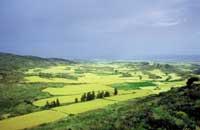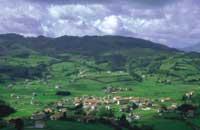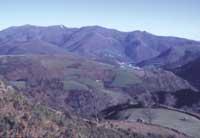Amateur news: July-August
1998/07/01 Elosegi Irurtia, Migel M. Iturria: Elhuyar aldizkaria

It is the one of the noon and in the shade we have a temperature of 30 degrees. We carry all day on sweat legs and only feels like lying down. At night, besides, it does not cool and with the glued sheets I spent half the night. However, the last day has been hard. With the help of the south wind, the sun has dried up every corner. Dust has predominated in the streets and most of the wells around the village have dried up exposing cracked land. The bright colors that the mountain had a few months ago have turned off and the south appears yellow and brown.
Summer, however, has many good things: the atmosphere to be on the street during the nights can be excellent and to recover lost water with sweat throughout the day, fresh beer enters perfectly. In addition, the festivals of most villages will be held during the summer. Therefore, it is very difficult to find excuses not to go out of play in summer.
Low water in wells

Green frogs are found on the banks of rivers and ponds and when enemies surround them they jump. In addition, there are cups in wetlands and they already have an advanced degree of development. At high temperatures they grow faster, but at the same time, the heat makes the water from the wells they inhabit can evaporate and dry. If the heat makes the whole well evaporate, everyone will die there. However, most amphibians are due to the fact that if dozens or hundreds of eggs are laid, the possibility of carrying out any of them is guaranteed.
Crop problems
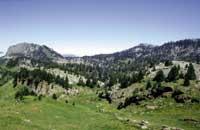
According to the word Julio, this is the tenor that is collected in many places. Although in the past the harvest was handmade, the advance of the technology caused a machining and the work is not as hard as then. For animals living in fields and fields, however, machining can become a problem. In fact, the harvesting utensils repress each year and leave it without offspring many eggs, chickens, etc., of partridges, quails, hens or viewpoints that breed in the wheat field.
When it was done by hand it was very normal, for example, that the partridge did not pick up a piece in its nest place to get ahead. However, with today's large machines it is not normally done, and although the best solution for animals is to delay harvesting in a few days, this can mean big losses for farmers and of course it is not done. Collection is therefore one of the biggest problems of the animals present.
Observing migration to Organbidexka
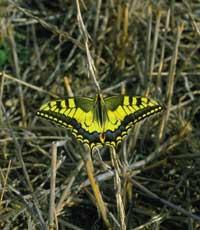
Even though winter is still far away, we have left the territories where white vultures have been raised and headed for Africa. In July the black milanos and white storks have also begun postbridal migration and the sorbells will be coming soon.
Many birds start migrating south in summer. In August, for example, the cuckoo, the ash eaglet, the blue eaglet and the common fly, among others, are torn off. These species came to grow into our territory and, once finished, they will be marked. For many people it may be surprising that some birds go full summer. Although the most spectacular migration occurs in autumn, the post-wedding journey begins in July. Among the different points of observation of migration in the Basque Country, one of the most famous is that of Organbidexka, where ornithologists carry out an annual follow-up.
Strategies to combat heat
Burumakur, the sheep are wrapped in the shade of a solitary oak. With these strong heat most animals look for shade and the head is the part of the body they must protect most. For its part, the group of cows has climbed to the top hill in search of a soft wind.
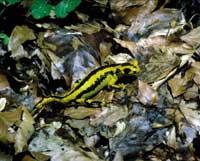
Like sheep and most pets, wild animals hide in cool places at the hottest times and move more at dawn and dusk. The Sarrios de la Dehesa have been lying in the celebrations where there are the last snows and the Basoilarra was already here eating the refreshing snow.
In the nests of the vultures that have not yet flown, the parents shade the offspring with the wings unfolded and in the water many animals enter to cool. However, if the wells dry completely, some species should be hidden in the mud and wait for the best times. Among the animals that stretch, or have a summer stop, we have some amphibians or supported.
Humans have similar behaviors. They can wear a beret or work scarf to protect the head, in the normal offices they turn on fans and in the official air conditioning. And certainly, those who can take a vacation and with this suffocating heat will try not to hit. However, instead of staying in the shade during the holidays, many human beings show a curious behavior during sunny days: lie down like lizards and let the sun drop their skin. To see this curious custom it is enough to approach these months to any beach of the coast.
With heat, many diseases
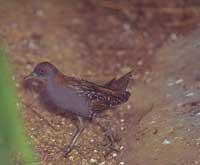
Deer do not know what to do. They are full of ticks and, if it were not enough, the ears cannot get rid of flies that are inserted through the nose, eye and mouth. In addition, these insects can cause the spread of diseases. One of the most harmful to wild animals is rabbit myxomatosis. Since the onset of this disease, millions of rabbits die every year in Europe and for the moment it has not been managed.
Sounds of thunder
Today's morning was very pretty, but the rough wind has begun to move and the evening sky has become black. The juicy clouds have grown and darkened and suddenly, BROOOOM, we have heard of thunder. After the thick initial drops it has knocked down an impressive one-hour storm.
Goodbye to outside beer and hot tubs, all inside the bar! To congratulate the peasants, the sweet rains in the calcined areas have wet the murky vegetables. Little by little the races have been growing and getting dirty, and as the trout have started jumping, like birds, to eat mosquitoes that have come down from the high layers of the atmosphere. At night, on the same road, we have seen numerous amphibians. The latter, without danger of skin dryness, did not want to miss this magnificent opportunity to throw dungeons, snails, etc.
Importance of wells

Although in the humid part of the Cantabrian we do not appreciate the water well, if we move towards the south of Álava and Navarra, we will discover the importance of the water. Water is alive and essential for all living beings. Yesterday's storm, for example, left beautiful wells in the mountains of Codés and soon many animals came to drink or bathe. Boars, for example, were there and despite being famous for being sharp and dirty, they are often cleaned to scare off skin and fur bugs.
Finally, I will remember two aspects of yesterday's storm, on the one hand, seeing that the firefighters' downpour was delighted to significantly reduce the risk of fire. On the other hand, the peasants asked us not to reduce the plots. Unfortunately, it was almost impossible to fulfill everyone's desire.

Gai honi buruzko eduki gehiago
Elhuyarrek garatutako teknologia



